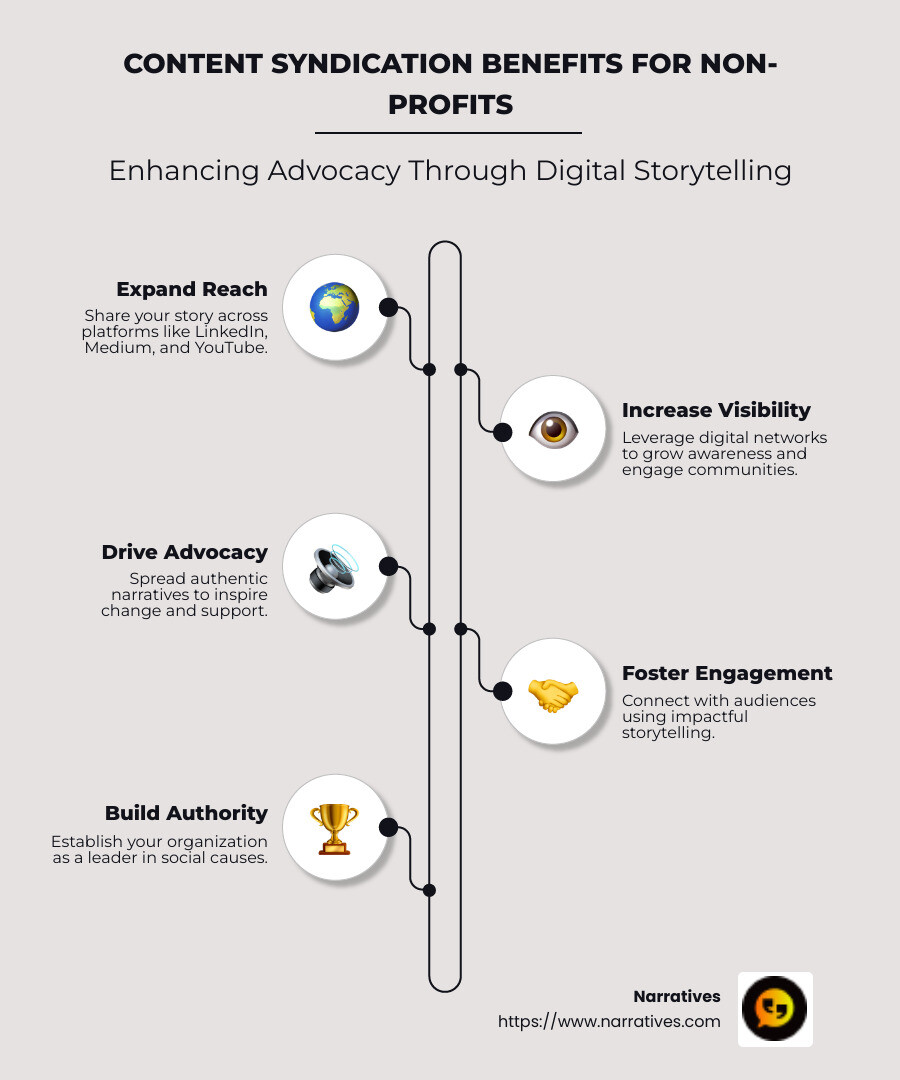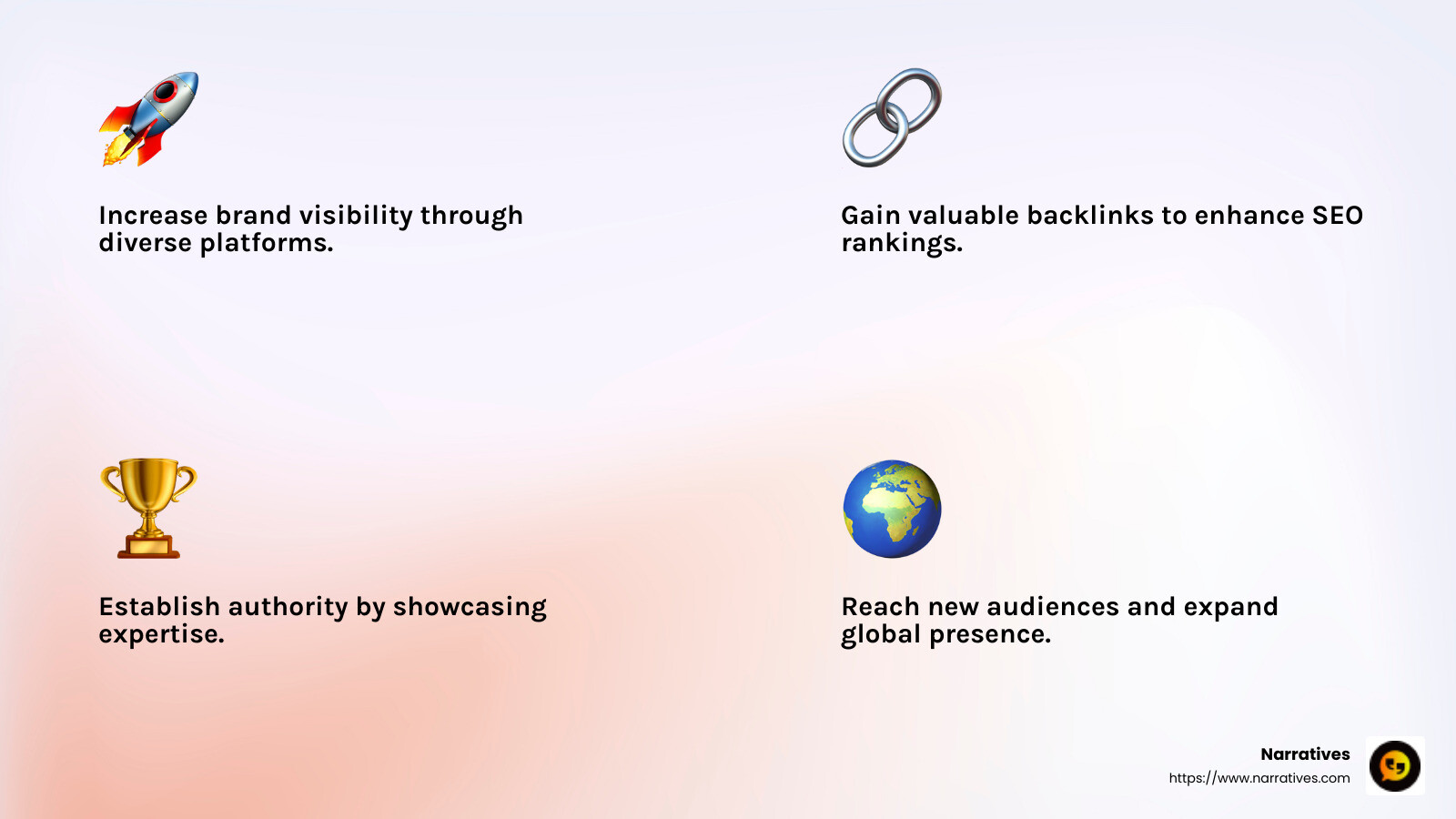Syndication Success Stories: Learn from the Best

Content syndication example success stories can inspire non-profits to amplify their messaging effectively. Imagine open uping a broader audience for your vital narrative without doubling your workload. This is the promise of content syndication—a strategy that propels your existing content to new platforms and eyes, enhancing visibility and engagement.
For non-profits striving to highlight their advocacy efforts, storytelling isn't just an art; it's a necessity. With content syndication, the impactful stories crafted to resonate with your audience can finally find their deserved spotlight across various channels. Consider the possibilities:
- Expand your reach: Share your story with platforms like LinkedIn, Medium, or YouTube without creating new content.
- Increase brand visibility: Leverage digital networks to grow awareness and foster community engagement around your mission.
- Drive ethical advocacy: Authentic narratives spread through syndicated content can drive real change and support for your cause.
For example, the inclusion of a heartwarming success story in a syndicated blog post not only educates and informs but also shines a light on social causes close to your organization's heart.

Content syndication example vocab to learn:
What is Content Syndication?
Content syndication is a powerful marketing strategy that involves republishing your existing content on third-party sites. This isn't about creating new material; it's about giving your existing stories a second life and reaching a broader audience.
How Does It Work?
When you syndicate content, you share it with other platforms or websites. These third-party sites might publish your content in full, or they could feature an excerpt and link back to the original. Either way, your content gets more eyes, and you get credit for it.
Why Use Content Syndication?
Reach New Audiences: By republishing your content on different platforms, you can connect with people who might never visit your site.
Boost Your Authority: The more your content appears on reputable sites, the more people will see you as an expert in your field.
Maximize Content Investment: You've already spent time and resources creating quality content. Why not get the most out of it by sharing it widely?
Key Considerations
Credit Matters: Always ensure the third-party site credits you and links back to the original content. This maintains your authority and directs traffic back to your site.
Avoiding Duplicate Content Issues: Use canonical tags to tell search engines which version of the content is the official one. This helps prevent any negative impact on your SEO.
Content syndication example: Picture your blog post about a successful community project being republished on a popular platform like Medium. Not only does this increase your reach, but it also boosts your credibility as more people engage with your message.
By embracing content syndication, non-profits can effectively spread their mission-driven stories, ensuring they resonate far beyond their immediate circles. This approach can amplify advocacy efforts and foster meaningful community engagement.
Content Syndication Example: Success Stories
When it comes to content syndication success stories, Narratives stands out as a shining example. This organization has mastered the art of storytelling to amplify the voices of non-profits and social justice causes. Their approach highlights how content syndication can lift important messages and reach a wider audience.
Narratives: A Case Study
Narratives has successfully partnered with organizations like Defy Ventures, which focuses on reducing recidivism by turning inmates into entrepreneurs. By syndicating content about Defy Ventures' impactful work, Narratives has helped bring attention to this vital cause. The content, shared on platforms with large audiences, has increased awareness and support for Defy Ventures' mission.

Industry Leaders and Successful Campaigns
Narratives isn't alone in leveraging content syndication. Industry leaders across various sectors have used this strategy to great effect. For instance, Company N, a software supplier, expanded its reach into European markets through a content syndication campaign. By localizing their content and using native-language translators, they successfully launched their flagship product in multiple countries.
This approach not only increased their market presence but also established them as a trusted brand in new regions. The campaign's success was marked by a significant increase in qualified leads and engagement rates, thanks to the strategic use of content syndication.
Key Takeaways
- Localized Content: Tailoring content to specific regions and languages can significantly improve the effectiveness of syndication efforts.
- Collaboration with Experts: Working with experienced content syndication suppliers can ensure high-quality, localized campaigns that resonate with target audiences.
- Measurable Success: Successful campaigns often result in increased engagement rates and a higher number of qualified leads, showcasing the power of content syndication.
By learning from these success stories, organizations can harness the potential of content syndication to amplify their messages and achieve their goals. Whether it's through storytelling or strategic partnerships, the possibilities are vast for those willing to explore this powerful marketing strategy.
Benefits of Content Syndication
Content syndication offers a treasure trove of benefits for organizations looking to amplify their reach and influence. Let's explore the key advantages: brand awareness, backlinks, and authority building.
Brand Awareness
One of the biggest perks of content syndication is the ability to reach new audiences. By sharing your content on platforms with large and diverse audiences, you can significantly expand your brand's visibility. Think of it like putting up a billboard on a busy highway—more eyes on your content means more people learning about what you do.
For example, when Narratives syndicated content about Defy Ventures, they reached audiences who might not have otherwise encountered this important cause. This kind of exposure is invaluable for non-profits and organizations aiming to spread their message far and wide.
Backlinks
Backlinks are the hidden gems of content syndication. They are links from other websites that point back to yours. These links not only drive traffic to your site but also boost your site's search engine rankings.
When your content gets syndicated, it's usually accompanied by a link back to the original source. This means more backlinks, which can improve your site's authority in the eyes of search engines like Google.

Authority Building
Building authority is about establishing yourself or your organization as a trusted source of information. Content syndication helps achieve this by putting your content in front of new audiences and on reputable platforms.
As more people engage with your content across various platforms, your reputation as an expert grows. This is especially beneficial for non-profits and organizations that rely on trust to drive support and engagement.
Narratives has demonstrated this by amplifying voices through storytelling, which not only shares important messages but also establishes them as leaders in digital storytelling.
In summary, content syndication is a powerful tool for increasing brand awareness, earning valuable backlinks, and building authority. By leveraging these benefits, organizations can amplify their impact and achieve their strategic goals.
Next, we'll explore the different content syndication formats that can be used to maximize these benefits.
Content Syndication Formats
Content syndication isn't just about sharing written articles. There are several formats to consider, each offering unique advantages. Let's explore some popular content syndication formats: blogs, infographics, videos, and audio.
Blogs
Blogs are the most common form of content syndication. They allow organizations to share detailed insights and stories. When syndicated on platforms like Medium or LinkedIn, blogs can reach a wider audience and attract new followers. For instance, Ben Hardy successfully grew his subscriber list from zero to 20,000 in just six months by syndicating on Medium.
Infographics
Infographics are perfect for those who prefer visual content. They can make complex information easy to digest and are highly shareable. A great example is Branticles, which syndicated an infographic on email marketing across multiple sites. This approach not only improves visibility but also encourages sharing, further extending reach.
Videos
Video content is booming. Platforms like YouTube offer a vast audience for syndicated videos. Take inspiration from Moz's Whiteboard Friday series, which syndicates SEO videos to YouTube. This not only boosts visibility but also engages viewers in a dynamic way.
Audio
Podcasts and audio content are gaining popularity as more people consume content on the go. Syndicating audio on platforms like Spotify or Apple Podcasts can reach listeners who prefer auditory learning. Shane Barker's Marketing Growth Podcast is an excellent example, available across multiple audio platforms, ensuring broad reach.
By understanding and utilizing these diverse content syndication formats, organizations can effectively reach and engage their target audience. Next, we'll dig into how non-profits can implement these strategies to amplify their storytelling and impact.
How to Implement Content Syndication for Non-Profits
Content syndication is a powerful tool for non-profits aiming to amplify their message and extend their reach. Here's how to effectively implement it by focusing on your target audience, storytelling, and multimedia content.
Know Your Target Audience
Understanding your audience is crucial. Non-profits often serve diverse groups, so tailor content to resonate with different segments. Start by identifying who you want to reach. Are they potential donors, volunteers, or the communities you serve?
Once you know your audience, choose platforms that align with their preferences. For example, if you're targeting younger demographics, consider platforms like Instagram or TikTok for visual content. On the other hand, LinkedIn might be more suitable for reaching professionals and potential corporate partners.
Accept Storytelling
Storytelling is at the heart of non-profit work. It's not just about sharing facts; it's about connecting emotionally with your audience. Use real-life stories to highlight the impact of your work. This not only engages your audience but also builds trust and credibility.
For instance, Narratives excels at creating compelling stories that humanize news and highlight community efforts. By focusing on the people behind the stories, they foster empathy and connection.
Use Multimedia Content
Diversifying your content formats can significantly improve your reach. Consider using a mix of blogs, infographics, videos, and audio to tell your story.
Blogs: Share detailed stories and insights. Syndicating blogs on platforms like Medium can help reach a broader audience.
Infographics: Simplify complex information and make it visually appealing. Infographics are highly shareable and can drive traffic to your site.
Videos: Capture attention with engaging visuals. Platforms like YouTube are excellent for syndicating video content.
Audio: Reach people on the go with podcasts. Syndicate your audio content on platforms like Spotify to tap into the growing podcast audience.
By using a variety of content formats, non-profits can effectively convey their message and engage with their audience across different platforms.
Implementing these strategies can help non-profits expand their reach and impact. Next, we'll explore some common questions about content syndication and how it affects SEO.
Frequently Asked Questions about Content Syndication
What is the difference between content syndication and guest posting?
Content syndication and guest posting are both effective strategies for expanding your reach, but they are not the same. Content syndication involves republishing the same piece of content on multiple platforms. This could be an article, a video, or an infographic, and it's usually marked with a line indicating where it originally appeared. The goal is to reach a wider audience by leveraging the existing readership of other sites.
On the other hand, guest posting involves creating original content specifically for another website. This content is unique to the host site and not published elsewhere. Guest posts are a great way to build relationships with other sites and showcase your expertise to a new audience.
How can content syndication affect SEO?
Content syndication can positively impact SEO if done correctly. The key is to avoid duplicate content issues, which can confuse search engines and potentially harm your rankings. To prevent this, ensure that syndicated content includes a link back to the original article and, ideally, a canonical tag. A canonical tag tells search engines which version of a page should be considered the primary one, helping to maintain the original content's SEO value.
Google is generally okay with content syndication as long as it's clear to both search engines and readers that the content is syndicated. By marking syndicated pieces appropriately, you can enjoy the benefits of increased exposure and backlinks without jeopardizing your SEO performance.
What are the best platforms for content syndication?
Choosing the right platform for syndication is crucial for maximizing your content's reach. Here are some of the best platforms to consider:
LinkedIn: Ideal for professional content and reaching a business-oriented audience. You can publish articles directly on LinkedIn to engage with industry peers and potential clients.
Medium: A popular platform for bloggers and writers, Medium allows you to tap into its large and diverse audience. Importing your blog posts here can help increase visibility and drive more traffic to your original site.
YouTube: Perfect for video content. By uploading and syndicating your videos on YouTube, you can reach a vast audience and improve your content's findability through YouTube's search and recommendation algorithms.
These platforms are excellent starting points for anyone looking to syndicate content and expand their audience reach. Next, we'll dig into some of the broader benefits of content syndication and how they can improve your brand's visibility.
Conclusion
Content syndication is more than just a marketing strategy—it's a way to tell your story to the world. At Narratives, we believe in the power of digital storytelling to lift voices that often go unheard. By partnering with non-profits and purpose-driven organizations, we help share impactful stories that resonate with audiences and inspire action.
Through community-driven storytelling, we aim to build trust and increase visibility for the causes that matter most. Our approach focuses on high-quality, emotionally resonant content that not only informs but also connects with viewers on a deeper level. This connection is crucial in building a supportive community around your mission.
By leveraging content syndication, you can amplify your message across multiple platforms, reaching new audiences and driving engagement. It's about creating a ripple effect, where each story told has the potential to inspire and mobilize others.
Ready to explore the opportunities that content syndication can offer your organization? Learn more about how Narratives can help you share your story and make a difference.
By focusing on storytelling and leveraging the right platforms, you can improve your brand's visibility and establish your organization as a thought leader in your field. Let's work together to tell stories that matter.


